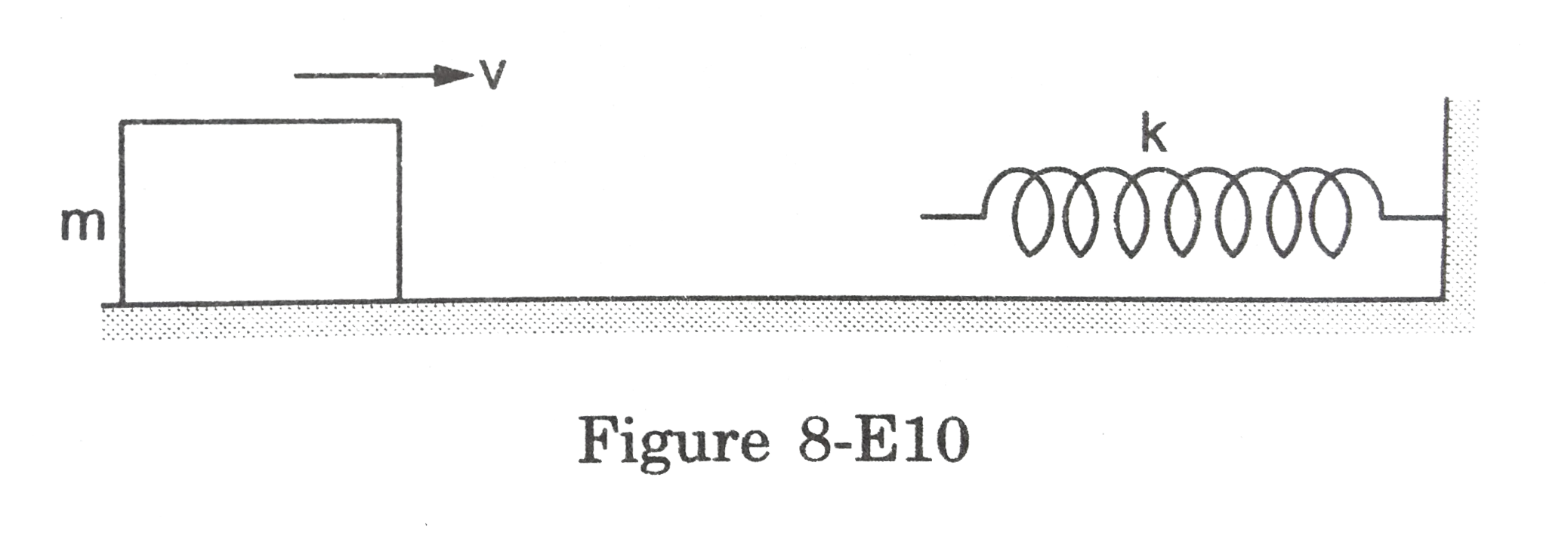A solid cylinder of mass is rolling on a horizontal surface with velocity . It collides with a horizontal spring of force constant . The maximum compression producec in the spring will be
The correct Answer is:B
To solve the problem of finding the maximum compression produced in the spring when a solid cylinder rolls into it, we can follow these steps:
Step 1: Identify the kinetic energy of the cylinder
The total kinetic energy (KE) of the rolling cylinder consists of both translational and rotational kinetic energy. The formulas for these are:
- Translational KE: KEtrans=12mv2
- Rotational KE: KErot=12Iω2
For a solid cylinder, the moment of inertia I about its axis is given by:
I=12mr2
And the relationship between linear velocity v and angular velocity ω is:
ω=vr
Step 2: Substitute the values into the kinetic energy equations
Substituting ω into the rotational kinetic energy formula:
KErot=12(12mr2)(v2r2)=14mv2
Now, the total kinetic energy of the cylinder is:
KEtotal=KEtrans+KErot=12mv2+14mv2=34mv2
Step 3: Set the kinetic energy equal to the potential energy of the spring
The potential energy stored in the spring when compressed by a distance x is given by:
PEspring=12kx2
At maximum compression, all kinetic energy will be converted into potential energy:
34mv2=12kx2
Step 4: Solve for x
Rearranging the equation to solve for x2:
x2=3mv22k
Step 5: Substitute the known values
Given:
- Mass m=3kg
- Velocity v=4m/s
- Spring constant k=200N/m
Substituting these values into the equation:
x2=3×3×(4)22×200
x2=3×3×16400
x2=144400
x2=0.36
Taking the square root to find x:
x=√0.36=0.6m
Conclusion
The maximum compression produced in the spring is 0.6m.
---
The total kinetic energy (KE) of the rolling cylinder consists of both translational and rotational kinetic energy. The formulas for these are:
- Translational KE: KEtrans=12mv2
- Rotational KE: KErot=12Iω2
I=12mr2
And the relationship between linear velocity v and angular velocity ω is:
ω=vr
Substituting ω into the rotational kinetic energy formula:
KErot=12(12mr2)(v2r2)=14mv2
KEtotal=KEtrans+KErot=12mv2+14mv2=34mv2
The potential energy stored in the spring when compressed by a distance x is given by:
PEspring=12kx2
34mv2=12kx2
Rearranging the equation to solve for x2:
x2=3mv22k
Given:
- Mass m=3kg
- Velocity v=4m/s
- Spring constant k=200N/m
x2=3×3×(4)22×200
x2=3×3×16400
x2=144400
x2=0.36
x=√0.36=0.6m
The maximum compression produced in the spring is 0.6m.
Topper's Solved these Questions
- BOOK - PRADEEPCHAPTER - WORK, ENERGY AND POWEREXERCISE - Comprehension9videos
WORK, ENERGY AND POWER
- BOOK - PRADEEPCHAPTER - WORK, ENERGY AND POWEREXERCISE - Integer Type Questions9videos
WORK, ENERGY AND POWER
- BOOK - PRADEEPCHAPTER - WORK, ENERGY AND POWEREXERCISE - NCERT( Multiple choide questions-1)21videos
WORK, ENERGY AND POWER
- BOOK - PRADEEPCHAPTER - THERMODYNAMICSEXERCISE - Assertion- Reason Type Questions19videos
THERMODYNAMICS
Similar Questions
A block of mass m sliding n a smooth horizontal surface with velocity →v meets a long horizontal spring fixed ast one end and having spring constant k as shown n figure. Find the maximum compression of the spring. Will the velocity of the block be the same as v whenit comes back to the original position shown?
 View Solution
View SolutionA body of mass 5 kg moving with a speed of 1.5 m/s on a horizontal smooth surface collides with a nearly weightless spring of force constant k = 5 N/m. The maximum compression of the spring would be
 View Solution
View Solution
Knowledge Check
- Question 1 - Select One
A solid cylinder of mass 3 kg is rolling on a horizontal surface with velocity 4ms−1. It collides with a horizontal spring of force constant 200Nm−1. The maximum compression produced in the spring will be
A0.5 mB0.6 mC0.7 mD0.2 m - Question 2 - Select One
A solid sphere of mass 2 kg is rolling on a frictional horizontal surface with velocity 6 m/s. It collides on the free end of an ideal spring whose other end in fixed. The maximum compression produced in the spring will be (Force constant of the spring is 36 N/m).
A√14mB√2.8 mC√1.4 mD√0.7 m - Question 3 - Select One
A solid sphere of mass 2 kg is rolling on a frictionless horizontal surface with velocity 6m/s. It collides on the free and of an ideal spring whose other end is fixed. The maximum compression produced in the spring will be
(Force constant of the spring = 36 N/m)A√14mB√2.8mC√14mD√0.7m
A mass of 0.5kg moving with a speed of 1.5m/s on a horizontal smooth surface, collides with a nearly weightless spring of force constant k=50N/m The maximum compression of the spring would be.
View SolutionA car of mass 1000 kg moving with a speed 18kmh−1 on a smooth road and colliding with a horizontally mounted spring of spring constant 6.25×103Nm−1. The maximum compression of the spring is
View SolutionA solid cylinder of mass 1 kg and radius 0.02 m, is rolling on a smooth horizontal surface with a uniform velocity of 0.1 m/s. Its total energy is
View Solutionmass of 0.5 kg moving with a speed of 1.5m/s on a horizontal smooth surface, collides with a nearly weightless spring of force constant k = 50 N/m. The maximum compression of the spring would be
 View Solution
View SolutionA mass of 0.5kg moving with a speed of 1.5m/s on a horizontal smooth surface, collides with a nearly weightless spring of force constant k=50N/m The maximum compression of the spring would be.
View Solution

